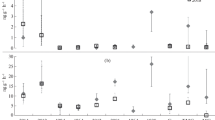Abstract
Purpose
Intensive urbanization leads to the use of ecologically unfavorable areas for construction. Expensive remediation may not produce the desired results. Risks of boundary ecosystems include pollution, reducing biodiversity, and human health deterioration remains. This applies to the reclaimed sewage filtration fields. The main factor of their environmental hazard before remediation is the sludge rich in organic matter whose decomposition under reducing conditions leads to methane and carbon dioxide accumulation in soils and emission to the atmosphere.
Materials and methods
Large areas of non-operational filtration fields were reclaimed and focused on the creation of residential areas in Moscow, outside the Garden Ring road and the Ring Highway. Conservative properties of technogenic surface-like soil formations (TSF) in parallel with their function were studied. Static soil properties were determined by the standard methods. Activity of bacterial methane formation and oxidation (biological indicators of function) were established using the kinetic methods by soil incubating in sealed vials and escaping or absorption of methane, respectively. Methane and carbon dioxide concentrations in soils and their emission to the atmosphere (gas characteristics of function) were determined by hole shooting method and closed chambers, respectively, with quantitative analysis at the gas chromatograph.
Results and discussion
The ground with sewage silt fragments (GS), Gleyic Technosol (GT), Urbic Technosol (Arenic, Transportic) (UT (AT)), and sandy Urbic Technosol (Humic, Transportic) (UT (HT)) are consistently formed during the reclamation of filtration fields. At the final stage in the greening of built area, Urbic Folic Technosols (UFT) are formed. In summer, CH4 generation decreases 10 times from GS and peat-compost horizons of new UFT to UT (HT), UT (AT), and UFT. Bacterial CH4 oxidation also decreases in the same row, after reducing CH4 content from 1,100-2,600 to 3–4 ppm. There is not enough oxidation intensity in GS and GT where high CH4 emission is observed; in other soils, it is absent. CO2 formation and emission, for an exception of UT (HT), decreases in the same row of soils.
Conclusions
Greenhouse gases generation, sink and emission, environmental functions of young subaerial soils 0–10 years old, are estimated. Seasonal monitoring revealed the risks of atmosphere pollution by CH4 during the cold period and by CO2—all year. Formed soils don’t emit CH4 in summer. Reclamation reduces atmospheric CH4 concentration from 60 to 2–4 ppm. The CO2 content is decreasing in the first years from 0.20 to 0.13–0.18 %, through 10 years—up to 0.08 %.


Similar content being viewed by others
References
IPCC (2007) Climate Change 2007: The physical science basis. Contribution of Working group I to the Fourth Assessment Report of the Intergovernmental Panel on Climate Change. Solomon S, Qin D, Manning M, Chen Z, Marquis M, Averyt KB, Tignor M, Miller HL (eds). Cambridge University Press. Cambridge, United Kingdom
Kaye JP, Burke IC, Mosier AR, Guerschman JP (2004) Methane and nitrous oxide fluxes from urban soils to the atmosphere. Ecol Appl 14(4):975–981
Koerner B, Klopatek J (2002) Anthropogenic and natural CO2 emission sources in an arid urban environment. Environ Pollut 116(1):S45–S51
Livesley SJ, Dougherty BJ, Smith AJ, Navaud D, Wylie LJ, Arndt SK (2010) Soil-atmosphere exchange of carbon dioxide, methane and nitrous oxide in urban garden systems: impact of irrigation, fertilizer and mulch. Urban Ecosys 13:273–293
Maltais-Landry G, Maranger R, Brisson J, Chazarenc F (2009) Greenhouse gas production and efficiency of planted and artificially aerated constructed wetlands. Environ Pollut 157:748–754
Nozhevnikova AN, Nekrasova VK, Lebedev VS (1999) Formation and oxidation of methane by microbial population of sediments sludge beds at low temperatures. Microbiology 68:267–272
Pei-dong T, Pei-jun L, Tie-heng S, Yao-wu H, Qi-xing Z, Zong-qiang G, Mizuochi M, Inamori Y (2002) Greenhouse gas emission from a constructed wetland for municipal sewage treatment. J Environ Sci 14(1):27–33
Robertson DS (2006) Health effects of increase in concentration of carbon dioxide in the atmosphere. Curr Sci 90(12):1607–1609
Shein E, Arhangelskaya T, Goncharov V, Guber A, Pochatkova T, Sidorova M, Smagin A, Umarova A (2001) Field and laboratory methods of research of physical properties and modes of soils. Publishing house of the Moscow State University, Moscow
Schmal AG (2010) Environmental hazards and environmental risks. Bronnitsy, Russia
Strom L, Lamppa A, Christensen TR (2007) Greenhouse gas emission from a constructed wetland in southern Sweden. Wetlands Ecol Manage 15:43–50
Teiter S, Mander U (2005) Emission of N2O, N2, CH4, and CO2 from constructed wetlands for wastewater treatment and from riparian buffer zones. Ecol Eng 25:528–541
Vadunina A, Korchagina Z (1986) Methods of research of physical properties of soils. Moscow
Vorob’eva L (1998) The chemical analysis of soils. Moscow
Wuebbles DJ, Hayhoe K (2002) Atmospheric methane and global change. Earth Sci Rev 57:177–210
Zvyagintsev DG (1991) Methods of soil microbiology and biochemistry. MSU, Moscow
Acknowledgments
This work was supported by grant from the Russian Foundation for Basic Research No. 12-04-00435-а.
Author information
Authors and Affiliations
Corresponding author
Additional information
Responsible editor: Przemysław Charzyński
Rights and permissions
About this article
Cite this article
Kulachkova, S.A., Mozharova, N.V. Generation, sink, and emission of greenhouse gases by urban soils of reclaimed filtration fields. J Soils Sediments 15, 1753–1763 (2015). https://doi.org/10.1007/s11368-014-0940-2
Received:
Accepted:
Published:
Issue Date:
DOI: https://doi.org/10.1007/s11368-014-0940-2




